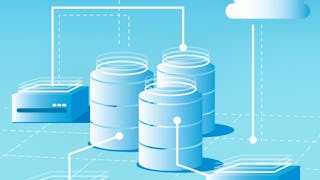This course provides a comprehensive overview of data, various data types, design of databases for storage of data, and creation and manipulation of data in databases using SQL. By the end of this course, students will be able to describe what business intelligence is and how it’s different from business analytics and data science, conduct a basic descriptive statistical analysis and articulate the findings, and differentiate between types of statistics. They will also be able to define normalization and ETL, create an ERD that shows progression from conceptual to logical to physical design, define DDL, DML, DCL, and TCL, and write SQL scripts to create a database and associated tables.

Enjoy unlimited growth with a year of Coursera Plus for $199 (regularly $399). Save now.

The Nature of Data and Relational Database Design
This course is part of Database Design and Operational Business Intelligence Specialization

Instructor: Tim Carrington
6,108 already enrolled
Included with
(102 reviews)
Recommended experience
What you'll learn
Create an ERD that shows progression from conceptual to logical to physical design
Conduct a basic descriptive statistical analysis and articulate the findings
Write SQL scripts to create a database and associated tables
Skills you'll gain
- Statistical Analysis
- SQL
- Business Intelligence
- Statistics
- Relational Databases
- Data Manipulation
- Database Management
- Business Analytics
- Database Design
- Database Management Systems
- Descriptive Statistics
- Extract, Transform, Load
- Data Literacy
- Microsoft Excel
- Data Science
- Data-Driven Decision-Making
- Decision Support Systems
Details to know

Add to your LinkedIn profile
4 assignments
See how employees at top companies are mastering in-demand skills

Build your subject-matter expertise
- Learn new concepts from industry experts
- Gain a foundational understanding of a subject or tool
- Develop job-relevant skills with hands-on projects
- Earn a shareable career certificate

There are 4 modules in this course
Welcome to Module 1: Overview of Business Intelligence! In our first module, we will define business intelligence and differentiate it from business analytics and data science. We will also overview decision support systems and practice working with them through our activity. Finally, we will differentiate between OTLP and OLAP as well as identify the goals of business intelligence through a short quiz.
What's included
7 readings1 assignment1 discussion prompt
Welcome to Module 2: Nature of Data & Descriptive Statistics. In this module, we will dive into the types of data, the process of data preparation and descriptive and inferential statistics. We will differentiate between descriptive and inferential statistics as well as structured and unstructured data with a short quiz. Finally, we will use Microsoft Excel Data Analysis Toolpak to conduct a basic descriptive statistical analysis and share our findings.
What's included
1 video4 readings1 assignment1 discussion prompt
Welcome to Module 3: Relational Database Design (ERD and Normalization). In this module, we will define relational databases and overview the process of designing databases. We will differentiate between conceptual, logical and physical design with a short quiz. In addition, we will create an ERD that shows progression from conceptual to logical to physical design through our activity.
What's included
4 readings1 assignment1 discussion prompt
Welcome Module 4: Structured Query Language (SQL) Overview. In our final module, we will overview SQL as well as define Data Definition Language (DDL) and Data Manipulation Language (DML). Through a short quiz, we will define DDL, DML, DCL, and TCL, as well as differentiate between varying MySQL keywords and data types. In our final activity, we will write SQL scripts to create a database and some associated tables. We will then extract and articulate useful information from the data that we can share with fellow students.
What's included
1 video1 reading1 assignment1 discussion prompt
Earn a career certificate
Add this credential to your LinkedIn profile, resume, or CV. Share it on social media and in your performance review.
Instructor

Offered by
Explore more from Data Management
 Status: Free Trial
Status: Free TrialIllinois Tech
 Status: Free Trial
Status: Free Trial Status: Free Trial
Status: Free Trial Status: Free Trial
Status: Free TrialUniversity of California, Irvine
Why people choose Coursera for their career




Learner reviews
102 reviews
- 5 stars
73.52%
- 4 stars
13.72%
- 3 stars
5.88%
- 2 stars
3.92%
- 1 star
2.94%
Showing 3 of 102
Reviewed on Feb 11, 2022
The topics are very interesting and I really want to use the things that I have learned from here.
Reviewed on Mar 26, 2023
It is a great course for a non-tech person. I would recommend this course to people want to advance their skills and change careers into Data

Open new doors with Coursera Plus
Unlimited access to 10,000+ world-class courses, hands-on projects, and job-ready certificate programs - all included in your subscription
Advance your career with an online degree
Earn a degree from world-class universities - 100% online
Join over 3,400 global companies that choose Coursera for Business
Upskill your employees to excel in the digital economy
Frequently asked questions
To access the course materials, assignments and to earn a Certificate, you will need to purchase the Certificate experience when you enroll in a course. You can try a Free Trial instead, or apply for Financial Aid. The course may offer 'Full Course, No Certificate' instead. This option lets you see all course materials, submit required assessments, and get a final grade. This also means that you will not be able to purchase a Certificate experience.
When you enroll in the course, you get access to all of the courses in the Specialization, and you earn a certificate when you complete the work. Your electronic Certificate will be added to your Accomplishments page - from there, you can print your Certificate or add it to your LinkedIn profile.
Yes. In select learning programs, you can apply for financial aid or a scholarship if you can’t afford the enrollment fee. If fin aid or scholarship is available for your learning program selection, you’ll find a link to apply on the description page.
More questions
Financial aid available,

